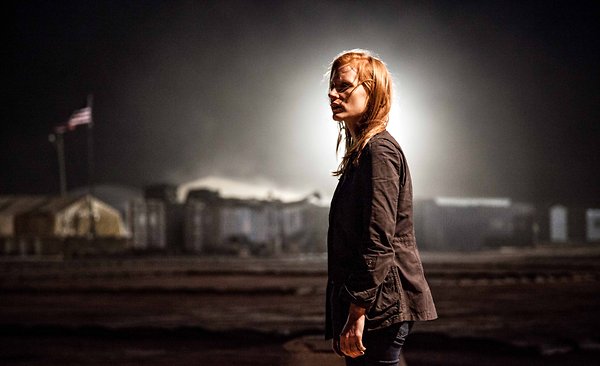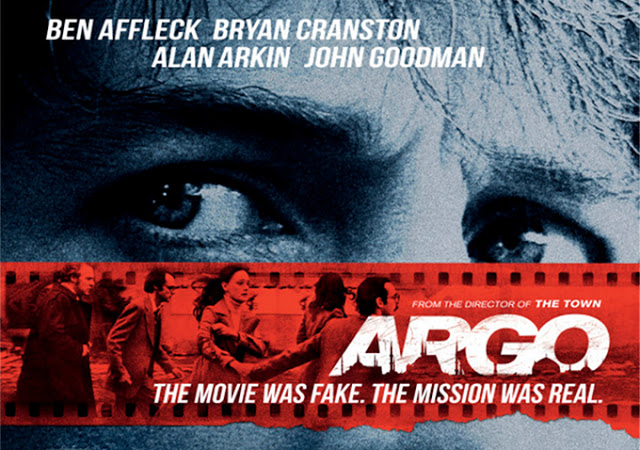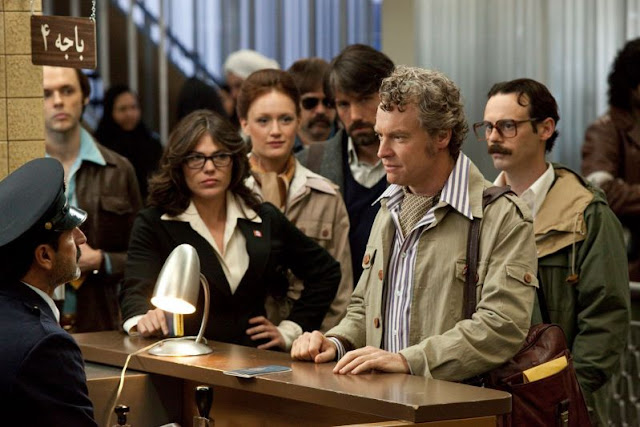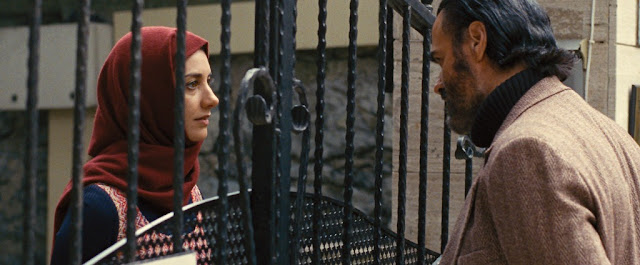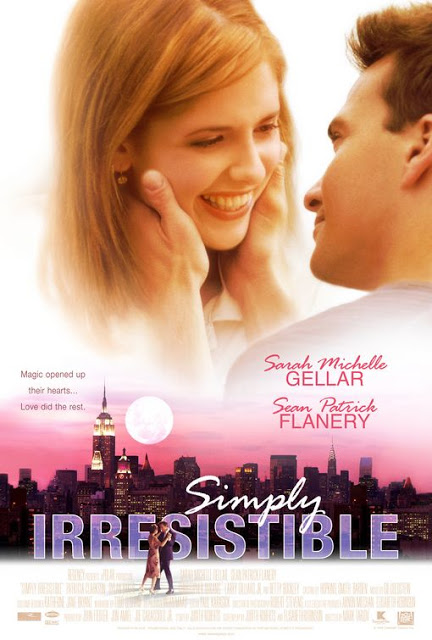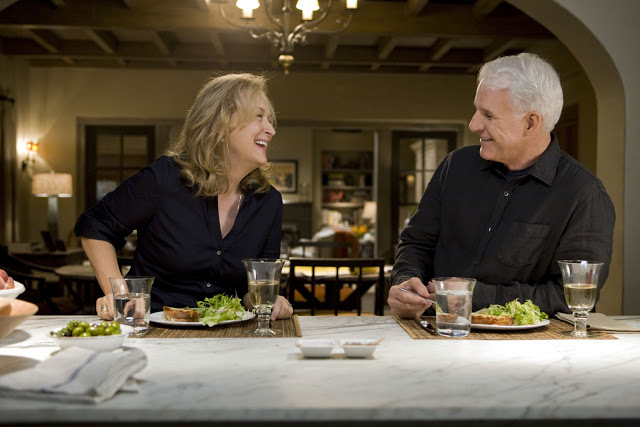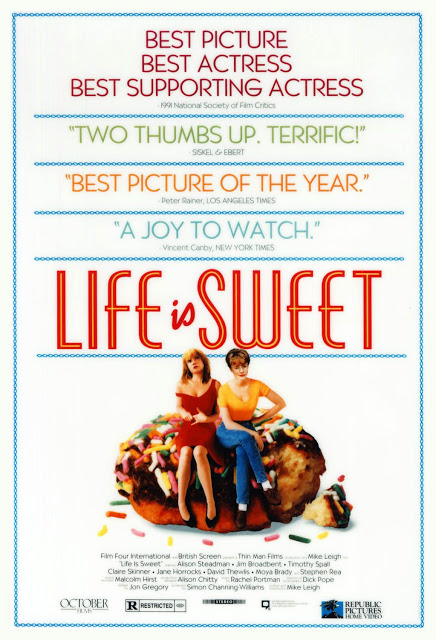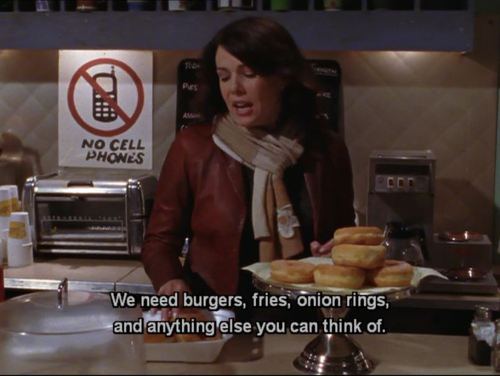Tag: Gender
Bitch Flicks’ Weekly Picks
Did We Have a Pro-Woman Golden Globes? by Renee Martin via Womanist Musings
A Salute to Girl Power in Hollywood by Alessandra Stanley via New York Times
Jodie Foster Coming Out: “This Is Something for Us” by Haviland Stillwell via AutoStraddle
New York Times Says “Female Directors Gain Ground Slowly.” Should We Wait That Long? by Melissa Silverstein via Women and Hollywood
Denzel and Quvenzhane Are the Only Actors of Color Nominated for Oscars by Jorge Rivas via ColorLines
Oscar and the Film Industry: Still a Men’s Club by Rachel Kassenbrock via Ms. Magazine
Kathryn Bigelow Oscar Snub: Does the Academy Hate Female Directors? by Christopher Zara via International Business Times
Parenthood Bravely Tackles Abortion by Willa Paskin via Salon
Why Girls Still Matters in Season 2 by Karensa Cadenas via Women and Hollywood
From M to Hushpuppy: The Best Flawed Female Characters of 2012 by Alyssa Rosenberg via The XX Factor
The Hobbit: Why Are There No Women in Tolkien’s World? by Ruth Davis Konigsberg via Time
Totally Rational Prediction: Women Will Rule Cable TV in 2013 by Alyssa Rosenberg via The XX Factor
Natalie Portman and Kristen Stewart Top Forbes’ List of Most Bankable Actors by Rebecca Pahle via The Mary Sue
The Hobbit: A Gender-Bending Journey by Natalie Wilson via Ms. Magazine
Teen Motherhood: When “Reality TV” Doesn’t Fully Reflect Reality by Avital Norman Nathman via RH Reality Check
Please share what you’ve been reading or writing this week in the comments!
2013 Golden Globes Week: ‘Zero Dark Thirty’ Raises Questions On Gender and Torture, Gives No Easy Answers
 |
| Jessica Chastain as Maya in Zero Dark Thirty |
Written by Megan Kearns. | Warning: Spoilers ahead!!
Driven, relentless, bad-ass women in film always hold a special place in my heart. Ripley from Alien and Aliens, Patty Hewes from Damages, Carrie Mathison from Homeland. Maya, the female protagonist of Zero Dark Thirty, is no exception. But can a film be feminist if it depicts horrific violations of human rights?
As Candice Frederick asserts, Maya anchors and propels the film. With a woman at the center of this story, it’s hard not to question gender. Zero Dark Thirty doesn’t overtly discuss gender politics, as Bigelow points out. Yet it reveals gender dynamics in subtle and important ways.
 |
| Maya (Jessica Chastain) in Zero Dark Thirty |
One of the best things about having a female director? Not only do we see an intelligent and complex female protagonist. We also see female friendship. Passing the Bechdel Test, we see Maya and her colleague and friend Jessica (Jennifer Ehle) debate, strategize, unwind and challenge each other. Reinforcing their friendship with a visual cue, Maya’s screensaver on her computer is a picture of her and Jessica.
 |
| Jennifer Ehle as Jessica in Zero Dark Thirty |
 |
| Maya (Jessica Chastain) in Zero Dark Thirty |
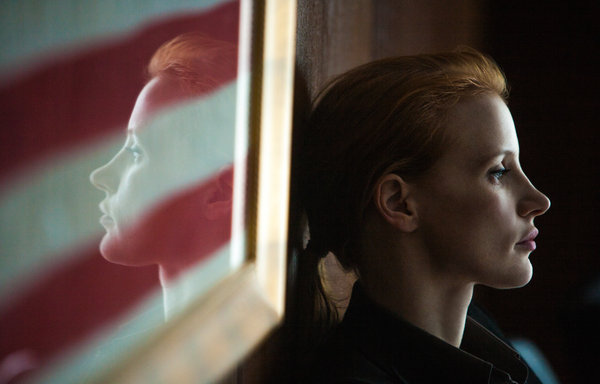 |
| Maya (Jessica Chastain) in Zero Dark Thirty |
Torture does not yield accurate information. Yet Dan repeatedly says to Ammar, “You lie, I hurt you.” When Ammar begs Maya for help, she tells him, “You can help yourself by telling the truth.” Not only does it subvert our gendered assumptions that she would be sympathetic to him. It puts the onus on the tortured detainees, not on the racist atrocities committed by government officials.
 |
| Admiral Bill McCraven (Christopher Stanley) and Maya (Jessica Chastain) in Zero Dark Thirty |
 |
| Maya (Jessica Chastain) in Zero Dark Thirty |
2013 Golden Globes Week: Does ‘Argo’ Suffer from a Woman Problem and Iranian Stereotypes?
Written by Megan Kearns.
“I’m not saying they should create a new role for a woman or magically create a female spy (it’s not Alias, after all), but the women here deserve more than virtual silence. The film doesn’t take place at an all-boys’ school or a magical world in which all of the women have gone mute. It was the 1970’s, not Spike TV. There were women who had relationships to the story, and the film’s desire to marginalize them or cut them out completely shows how little modern Hollywood thinks of female narratives. Movies actually made in the 70’s had better roles for women than this, and the idea that Affleck gets let off the hook for sexism because he made a period piece is insulting…As a movie about movies, Argo wants to hold up a mirror to Hollywood and reflect the craziness of the industry, but in doing so, also perpetuates that industry’s rampant and systemic sexism.”
“But throughout the film, the Iran we see in the news clips and the Iran we see dramatized are all on the same superficial level: incomprehensible, out-of-control hordes with nary an individual or rational thought expressed…Argo glosses over the diversity of opinion in Iran and the intellectual ferment before the theocratic lockdown, making the culture look exactly the way an insular American public has come to believe all Islamic countries look.”
Interestingly, Ben Affleck told The Huffington Post’s Michael Hogan that the filmmakers changed the gender and nationality of the Taylor’s housekeeper:
“I changed it because I wanted to represent a Persian character that wasn’t a fanatic, that wasn’t railing against the United States, but that’s just somebody like all of us who’s trying to go to work and feed their family and do all the things they need to do, and who’s kind of buffeted by the political winds that are kicked up by others, particularly by others that are higher up than them.”
“But calling her the most important Iranian character is not saying much — and neither is Sahar. Over a handful of scenes she may have a grand total of 3 lines. In this case they are translated, because they are relevant to the plot. Her character, however, is defined by her attitude toward the Americans. She also may be the only kind of Iranian the movie is interested in individuating because she is separated from her society, ensconced in a Western household.”
Just like the other women in Argo, Sahar’s opinions and views are erased. Her importance truly lies in how she relates to men.
Argo shows how far we still have to go in gender equity in film. Sure, it’s a well-made movie. But that doesn’t inoculate it from sexism or racism. Awards indicate the art, culture and opinions we value. Just like somany Golden Globes and Oscar-nominated films, Argo revolves around men. Women deserve better. We’re not just satellites orbiting dudes.
Call for Writers: Women in Classic Literature Film Adaptations
Here are some suggested film adaptations but feel free to suggest your own:
Little Women
The Color Purple
Jane Eyre
Gone With the Wind
The House of the Spirits
Sense and Sensibility
To Kill a Mockingbird
Romeo and Juliet
Women Without Men
A Streetcar Named Desire
Wuthering Heights
Dune
Love in the Time of Cholera
Their Eyes Were Watching God
The Great Gatsby
Dracula
Blade Runner
Out of Africa
Raise the Red Lantern
Emma
The Lord of the Rings
Hamlet
Cry the Beloved Country
Vanity Fair
Moll Flanders
Alice in Wonderland
The Crucible
Beloved
Tess of the D’Urbervilles
Doctor Zhivago
A Room with a View
Lolita
The Portrait of a Lady
The Good Earth
Remains of the Day
Dangerous Liasons
Age of Innocence
A Raisin in the Sun
The Wizard of Oz
Gender and Food Week: Trophy Kitchens in Two Nancy Meyers’ Films, ‘Something’s Gotta Give’ and ‘It’s Complicated’
 |
| Diane Keaton in Something’s Gotta Give |
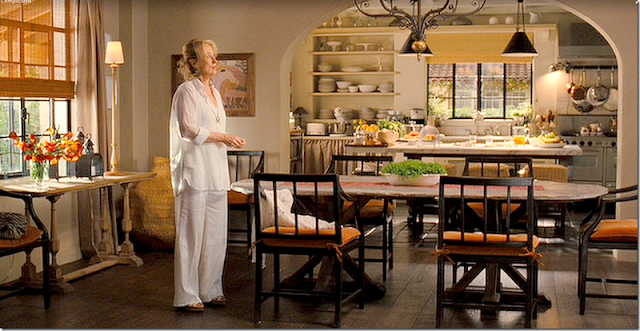 |
| Meryl Streep in It’s Complicated |
 |
|||||
| Kitchen from Something’s Gotta Give |
 |
| Kitchen from It’s Complicated |
“It got to the point where I started to resent the whole house. It seemed like people were giving it more attention than the movie (quoted in Green and Baldwin, 2006).”
Unpacking the Meyers Mark
 |
| Living room in Something’s Gotta Give |
“But in the end she’s dipping deep into the bourgeois mainstream, with its longing for Oprah-like ‘closure,’ its peculiarly American belief in personality makeovers and its abiding love for granite kitchen counters (2009).”
- Collins, Nancy. 2003. “Set Design: Something’s Gotta Give. Setting the Scene for Romance in the Hamptons.” Architectural Digest. Accessed February 10, 2012.
- Green, Penelope and Deborah Baldwin. 2006. “Updating the Trophy Kitchen: Filmmaker is an Unwitting Trendsetter.” The Sun Sentinel. October 20. Accessed October 15, 2011.
- Fallon, Mona. “Something’s Got to Give Kitchen Design.” Island Spot: Long Island Home Living Website. Accessed March 7, 2012.
- “Friends of the Kitchen: Something’s Gotta Give Set Designer Beth Rubino.” Sub Zero-Wolf Website. Accessed March 7, 2012.
- Janet. 2009. “Steal This Look: It’s Complicated Kitchen Accessories.” Textiles & Textures. 3(51): December 21-27. Accessed March 7, 2012.
- Julia. “The Beach House in Something’s Gotta Give.” Hooked on Houses Blog. May 4, 2009. Accessed March 7, 2011.
- Killam, Maria. 2010. “A ‘Something’s Gotta Give’ Kitchen Cabinet Dilemma.” Colour Me Happy Blog. January 10. Accessed March 7, 2012.
- “Something’s Gotta Give Kitchen.” Fran Jacoberger Blog. Accessed March 7, 2012.
Gender & Food Week: ‘Simply Irresistible’
At the film’s beginning, handed down the reins and lacking the expertise that her deceased mother had to make the restaurant Southern Cross thrive, Amanda Shelton (Sarah Michelle Gellar) is a terrible chef (or in her words “shitty”) and because of that, the financially troubled restaurant will be closing.
Enter Harry Bendel’s savvy businessman Tom Bartlett (Sean Patrick Flanery). Earlier introduced to Amanda by the strange Gene O’Reily who also moonlights as a taxi cab driver, Tom and his soon-to-be-ex-girlfriend, Chris (Amanda Peet) are unceremoniously dropped off at the Southern Cross.
 |
| Tom Bartlett (Sean Patrick Flanery) and Amanda Shelton (Sarah Michelle Gellar) in Simply Irresistible |
 |
| Amanda (Sarah Michelle Gellar) and Tom (Sean Patrick Flanery) in Simply Irresistible |
 |
| Amanda (Sarah Michelle Gellar) in Simply Irresistible |
 |
| Lois (Patricia Clarkson) in Simply Irresistible |
Her supporting character, Lois, a feisty woman pining lustily after Bendel heir Jonathan (Dylan Baker), stole the show and Tom’s box of Amanda’s famous éclairs that he himself had snatched away from an old lady. In this hilarious scene, she relishes her thievery. “Gotta learn to share Tom,” she chirps, devouring the stolen dessert and moaning her pleasure while Tom is left to lick caramel residue from the empty box.
Gender & Food Week: A Woman’s Place in the Kitchen: The Cinematic Tradition of Cooking to Catch a Man
Early in the 1954 film Sabrina — the original, starring Audrey Hepburn and Humphrey Bogart — the titular ingenue finds herself at a cooking school in Paris. Sent over as a gift from her father’s employer, the wealthy Larabee family, Sabrina continues to nurse her crush on the younger Larabee son, David (William Holden), even from Paris, and it shows in her cooking. The head chef inspects her souffle, and declares it “Much too low.” “I don’t know what happened,” she moans pitifully to herself. “I know what happened,” her colleague, a much older French gentleman, says, “You forgot to turn on the oven.” She cries out, and he guesses that she is in love—unhappily in love. “A woman happily in love, she burns the souffle. A woman unhappily in love, she forgets to turn on the oven.”
Cooking has always been a creative act, no matter who’s doing the dishes — it requires careful thought, imagination, and precision. It is, in short, one of the most skilled professions that anyone can take on, and also one of the most generous professions, because it requires thinking deeply about another person’s needs and desires. However, when a woman cooks for a man, and in doing so wins his heart, the woman appears conventionally domestic and feminine — traditional in her skill sets, understanding of her appropriate role in the house and in the relationship, and so subservient to the man’s needs. When a woman cooks on film, even when she cooks something extraordinary, there’s something profoundly submissive when she does it to please a man.
 |
| Ruth Younger (Ruby Dee) and Walter (Sidney Poitier) in A Raisin in the Sun |
In the very beginning of the 1961 film A Raisin in the Sun, Ruth Younger (Ruby Dee) is trying to stir her husband Walter (Sidney Poitier) to start his day — he wants to talk about his dreams, his ambition, and she keeps reminding him to eat his breakfast. He lambasts her for her intolerance, but her means of affecting change — and her means of keeping the family together — have been limited to the kitchen.
 |
| Like Water for Chocolate |
This impulse, to cook to incite pleasure and admiration, even surfaces in more modern films when women would be seemingly more self-sufficient. As recently as 2011’s It’s Complicated, Meryl Streep’s pastry chef gets to be the object of two men’s lusts, in part, in no small part because she’s a spectacular cook. The scene of her late-night date with a new love interest (Steve Martin), where she makes him chocolate croissants from scratch, shows her at her most ebullient (and sexiest) throughout the film. And it’s only a few scenes later that her ex-husband (Alec Baldwin) tells his kids that their mother is the “best cook in the world.” Her talent equals her desirability, displayed in her gift to create a warm, indulgent space for the men in her life.
These scenes aren’t so disquieting on their own—after all, who wouldn’t want to be served a meal infused with lust, or have Meryl Streep bake you croissants at 2am? But the inverted message also comes that, when a woman lacks warmth or compassion, it shows in her cooking.
In Clueless, as Cher (Alicia Silverstone) prepares for a date, her voiceover tells us that “When a boy is coming over, you should always have something baking.” The punchline is then seeing her unwrap an entire roll of frozen cookie dough and dropping it onto a baking sheet. (No surprise later that the entire roll burns to a crisp. “Aw, honey, you baked,” her date condescends. “I tried,” she whimpers.)
The heroine in Mostly Martha, the spectacular 2001 German film, is a good cook, the head chef of a great restaurant, but her cooking doesn’t translate when she has to take care of her niece, Lina. It takes a more genial Italian sous-chef (and Martha’s future love interest) to get the child to eat, and instead of a sophisticated dish, it’s a simple plate of spaghetti that does the trick.
Where Martha’s ambition is rewarded in the restaurant world, it’s punished when she has to act as a surrogate mother (and potential girlfriend). Only once she’s later softened in the film does her cooking — and her parenting — relax to the point of acceptance. But in reality, women don’t just cook for themselves — most of the time, the act of cooking is done as an expression of survival, rather than seduction. Preparing a meal is one indication that a person is fully self-sufficient. It’s a biased opinion, I know, but I raise an eyebrow at anyone, male or female, who tells me that they don’t ever cook for themselves. While making boeuf bourguignon or baking a seven-layer cake takes a greater level of culinary ambition, preparing a series of simple, satisfying dishes show the difference between someone who can take care of themselves, and someone who requires a babysitter.
 |
| Amelie (Audrey Tautou) in Amelie |
The brief scene in Amelie of the heroine preparing her dinner shows us what adulthood looks like — even when adulthood also comes with skipping stones and playing pranks on the local butcher. And no model proves more inspiring than Janette deSautel, the female chef from HBO’s Treme, whose narrative about her New Orleans’s restaurant is entirely without romantic motivation. Even when her restaurant crumbles due to the post-Katrina economy, she rebuilds her reputation in the hard-scrabble New York restaurant scene. By bringing her New Orleans roots to bear in standout dishes at David Chang’s fictionalized restaurant Lucky Peach, she reestablishes herself as a chef to watch — and finds a new avenue toward her culinary career back in her hometown.
 |
| Chef Janette deSautel (Kim Dickens) in Treme |
And finally, there is Julie & Julia, the story of a modern-day woman (Julie Powell, played by Amy Adams) finding inspiration in Julie Child (Meryl Streep, yet again), and using cooking to dig herself out of her personal and professional ennui. Cooking in this story threatens to tear Julie’s marriage apart — not for her lack of skill, but her preoccupation with what the cooking might mean. Her husband (Chris Messina) doesn’t mind being fed, but he does mind her obsession with letting her cooking skill transform her life. When redemption comes, you know it’s arrived when her husband gives in, asking with a smile “What’s for dinner?” Food becomes a means of personal empowerment, rather than seduction…even if it’s ultimately the husband being fed. And, at least in Julie & Julia, it puts the husband in the role of the sous chef, the kitchen support system, even when the cook is melting down over her lack of trussing ability.
Gender & Food Week: ‘Life is Sweet’
Guest post written by Alisande Fitzsimons.
from Bulimia.
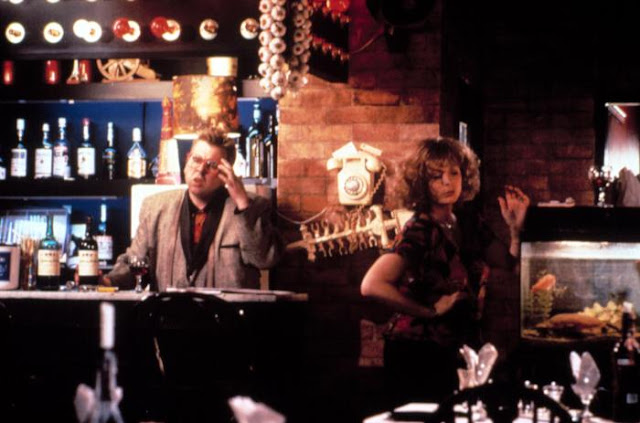 |
| L-R: Aubrey (Timothy Spall) and Wendy (Alison Steadman) in Life is Sweet |
A little way into the film, Wendy takes a job at the Regret Rien, a restaurant that’s just been opened by a family friend. Parisienne-themed and — there’s no way around this — as clichéd as fuck, the Regret Rien is also in possession of one of the most revolting menus in modern cinema (and I’m including films in which
Gender & Food Week: Pop-Tarts and Pizza: Food, Gender, and Class in ‘Gilmore Girls’
 |
| Lorelai Gilmore (Lauren Graham) in Gilmore Girls |
Guest post written by Brianna Low.
 |
| Lorelai (Lauren Graham) and Rory Gilmore (Alexis Bledel) in Gilmore Girls; image via Emily Grenfell |
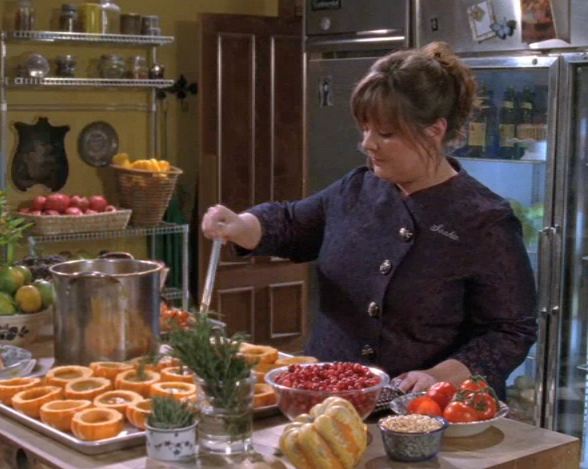 |
| Sookie St. James (Melissa McCarthy) in Gilmore Girls |
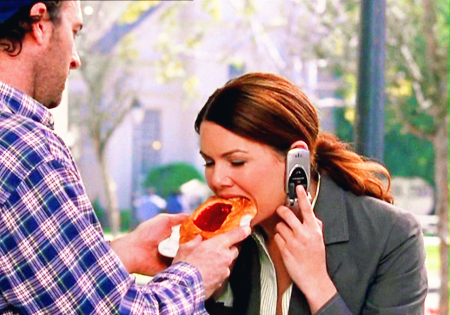 |
| Lorelai Gilmore (Lauren Graham) in Gilmore Girls |
Throughout all seven seasons Luke is often shown bringing food to the Gilmore’s when they are in need. For example, when Lorelai’s father is hospitalized after a heart attack, Luke brings food to Lorelai and her family at the hospital. Inasmuch as food can be gendered, diners and diner food fare with its burgers, fries, and malts often tend to be coded as masculine, however Luke is an interesting case in that he refuses to eat his own food. Although he is never explicitly referred to as a vegetarian, Luke is shown refusing to eat hamburgers and often refers to meat as “dead cow”. When Luke and Lorelai start dating and eventually move in together, Luke is decidedly more active in their domestic affairs, taking charge of the cooking and their home remodel. While this might not be the most shocking or unheard of example of stereotypical role reversal in heterosexual relationships, it’s definitely interesting when examining Luke and Lorelai’s relationship with food and each other.
 |
| Gilmore Girls |
Bitch Flicks’ Weekly Picks
Megan‘s Picks:
How to Increase Media Diversity: 3 Lessons from the London Feminist Film Festival by Spectra via Racialicious
Female Trouble: Why Powerful Women Threaten Hollywood by Sasha Stone via Awards Daily
Why Having Only Strong Girl Heroines Is Not Enough by Melissa Silverstein via Women and Hollywood
Matt Lauer Is Gross, Anne Hathaway Kicks Slut-Shaming’s Ass by Jos Truitt via Feministing
Women of Color Talk Back: “Birthday Song” via FAAN Mail
Shonda Rhimes On Why She Has Many Gay Characters on Her Shows by Melissa Silverstein via Women and Hollywood
The Female Pilots Who Were Cut From ‘Return of the Jedi’ and the Future of Star Wars by Alyssa Rosenberg via Think Progress
Why Talking About Character Gender Still Matters (Even Though It Shouldn’t) by Becky Chambers via The Mary Sue
Serena Williams Is Not a Costume by Jessica Luther via Speaker’s Corner in the ATX (scATX )
‘The Mindy Project’: The Best Show You’re Not Watching by Molly McCaffrey via I Will Not Diet
The Censorship of ‘Mean Girls’: What Was MTV Thinking? by Ramou Starr via Hello Giggles
If Women Ran Hollywood… by Karensa Cadenas via Women and Hollywood
What have you read (or written) this week that you’d like to share?
Call for Writers: Gender and Food in Film and TV
Food symbolizes nourishment, fulfillment and passion. Food can be a way to connect with family (Soul Food, Tortilla Soup, Pieces of April) or even rekindle love (Chocolat). Competitive cooking shows like Top Chef or Hell’s Kitchen often divide teams into men vs. women. For vegans and vegetarians, food intertwines with identity (The Simpsons‘ Lisa Simpson, Roseanne‘s Darlene Connor). Some women have found liberation through food (Eat, Pray, Love) and a way to express their voice through cooking (Julie & Julia, Waitress).
Soul Food
Pieces of April
Eat, Pray, Love
Babette’s Feast
Alice
Tortilla Soup
Eating
Cheers
I Am Love
Super Size Me
Sideways
Ratatouille
Tampopo
Willy Wonka and the Chocolate Factory
The Cook the Thief His Wife & Her Lover
The Mistress of Spices
Two Guys, a Girl, and a Pizza Place
Top Chef
Woman on Top
Fried Green Tomatoes
